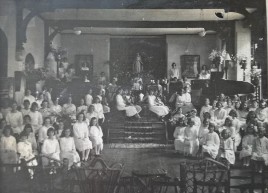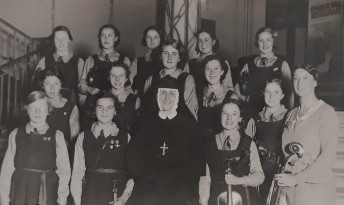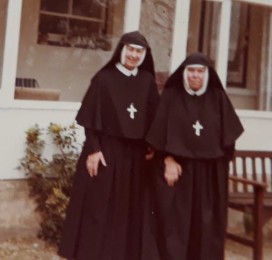11 August 2021
From the European Province Archives…
Today’s article looks at the role of music within the SHCJ schools. It focuses on the lives of several musician-sisters of the SHCJ and the spirit in which they taught.

Having once been a music teacher in Grand Coteau with happy memories of songs around the piano with her own children, Cornelia took this subject seriously. In the section of the Book of the Order of Studies dedicated to the teaching of music, she gives thorough instructions by which key concepts should be conveyed to pupils alongside the gradual development of sight-reading.
The experience of Cornelia and those who helped her author the Book of Studies is apparent in her warning to avoid giving the impression that an octave is five tones and two halves, ‘which children generally first take in, much to their future confusion’. The Book of Studies also makes it clear that music lessons should be enjoyed by pupils, to be ‘made recreative’ by spending time ‘in the exercise of agreeable sounds’. It is better to leave further explanation of musical technicalities to a later lesson ‘as soon as there is an appearance of weariness’ in pupils. It seems important to Cornelia and her collaborators that nothing should be done to discourage children from engaging with music and understanding it.

While Cornelia herself taught at St Leonards, she noticed a particular gift for music in one of the girls. This pupil went on to become Mother Mary Cornelia Poett. As a SHCJ at Mayfield, Mother Mary Cornelia was devoted to the choir and teaching music there. She moved to Combe Bank in 1926 where she carried on her dedication to music. Her necrology states that ‘her last work’ was the preparation of the school choir for the Feast of St Joseph, celebrated only days before she died aged 74.
M.M. Cornelia’s time at Mayfield would have crossed over with another SHCJ with a passion for music, Sister Mary Simeon Grogan. A violinist, during her youth she studied music for four years in Germany and went on to become a member of the London Academy of Music. She came into contact with the SHCJ while working at the Settlement in Poplar. After she entered the Society at Mayfield, she stayed there from 1917 to 1939 working as a class mistress, assisting with the teaching of music and finally becoming the prefect of the school. As superior at Cavendish Square while the Second World War began and a key figure in the establishment of Slynedales School in Lancaster, her hard work between 1939 and 1943 had taken its toll on her health. Nevertheless, when she came to Layton Hill ‘the challenge of a large, understaffed school was irresistible’ and she threw herself into teaching violin, becoming part of the orchestra and teaching scripture to evacuee children.
While Sister M. Simeon was teaching at Layton Hill, the school was visited by a Danish violinist, Henry Holst. He appears to be no relation to the composer of ‘the Planets’ suite but was a successful musician and academic in his own right. Before moving to the Royal College of Music in London, Henry Holst was a professor at Royal Manchester College of Music. He repeatedly gave recitals at Layton Hill, on one occasion bringing his protégé Regis Plantevein in 1946. Keen to sharpen her skills and give her best to the girls she taught, Sister M. Simeon took the initiative to request a masterclass from the Professor. Her necrology states that his teaching ‘revolutionised her technique, to the great advantage of her pupils’.

An even larger group of sisters were able to brush up their musical skills when from the 29th July to the 17th August 1948, Layton Hill hosted a music course. It was attended by 31 SHCJ. They were joined by Mary Burke, an old girl who had become a Sister of Charity. The Layton Hill house diary records that the sisters had a class in plain chant from Father Lea and went on to sing what they had learnt at a Sung Mass a few days later. There were also films on the instruments of the orchestra and the course ended with the attendees giving a recital including Leopold Mozart’s Toy Symphony.
Further musical exploits by the staff and pupils of Layton Hill included auditioning and being broadcast over B.B.C. Radio in 1949. The author of the notice modestly states that the choir ‘were disappointed’ on listening to themselves but admits that a letter was received claiming the girls ‘sung like Angels in Heaven’.

Layton Hill’s musical talent was also showcased in the school orchestra and choir classes of the Blackpool Musical Festival from 1933 onwards.9 The orchestra was conducted by Sister Felicitas, (later known as Sister Evelyn) Picken during this period, who not only created two orchestras ‘with untiring energy’ but also ran musical appreciation classes allowing girls to listen and understand music that one Layton Hill pupil states ‘would otherwise not have been within our reach’.10 Sister Evelyn is praised in her necrology for her thoroughness and the way in which all her students improved their level of playing whether ‘gifted’ or ‘average’.

This very same quality was also apparent in Mother Mary Chrysostom Bates who, as a fellow SHCJ music teacher based at Preston and later Edgbaston, would travel to Layton Hill to work with Mother Mary Wenceslaus and Sister Evelyn, helping to assess the choirs of Layton Hill’s houses. In 1935 she ‘made very helpful suggestions and gave much encouragement’.12 She was able to bring out the best in those she taught with most finding ‘some often unsuspected capability for singing or appreciation of music’. As M.M. Chrysostom’s health began to fail in her last year at Edgbaston, her older students ‘were able to carry on the school music’ due to her teaching.
Musical talent often runs in families. Such was the case for the Picken sisters who shared both a love of music and a vocation for the SHCJ. A year before Evelyn entered the Society, her elder sister Sarita joined the novitiate. In her youth, Sarita was determined to study violin and piano. At the Sydenham Conservatoire, she overcame a lingering weakness in her right hand caused by the infantile paralysis she had suffered as a small child and continued her education. Sarita took the religious name Sister Mary Clotilde possibly in honour of Mother Mary Clotilde Celineau from whom she received instruction before being received into the Catholic Church.
Sister Clotilde’s ministry in music was based at Combe Bank where she too established an orchestra as well as playing the organ in church. She was remembered by past pupils as having a ‘gift for inspiring a love of music’ and being ‘strict but gentle’. One community member described how “she always made you feel that you really mattered”.
When Sister Clotilde became part of the SHCJ community in Hastings, she was still able to teach piano and these lessons continued until her last year, 1981. When her sister Evelyn came to Hastings in 1986, an SHCJ remembered how she too continued the devoted practice of her chosen art and retained a powerful sense of music. Despite her deafness, Sister Evelyn could correct her fellow SHCJ’s playing by sight and vibration during their duets since ‘she had, like Beethoven, the notes in her head’.

Through the lives of sisters who taught music, we can see a continuance of both Cornelia’s comprehensive and thorough approach to education and her emphasis on seeking an individual’s potential in order to nurture it. From Mother Mary Cornelia Poett to the Picken sisters, these SHCJ members not only shared their talent through honing their skills and performance, but also sought to inspire a passion for music in their pupils, equipping them with the ability to express themselves through this complex and technical art. It is, perhaps, one of the most profound acts of love and generosity to share what gives you the greatest joy.


Comments are closed.